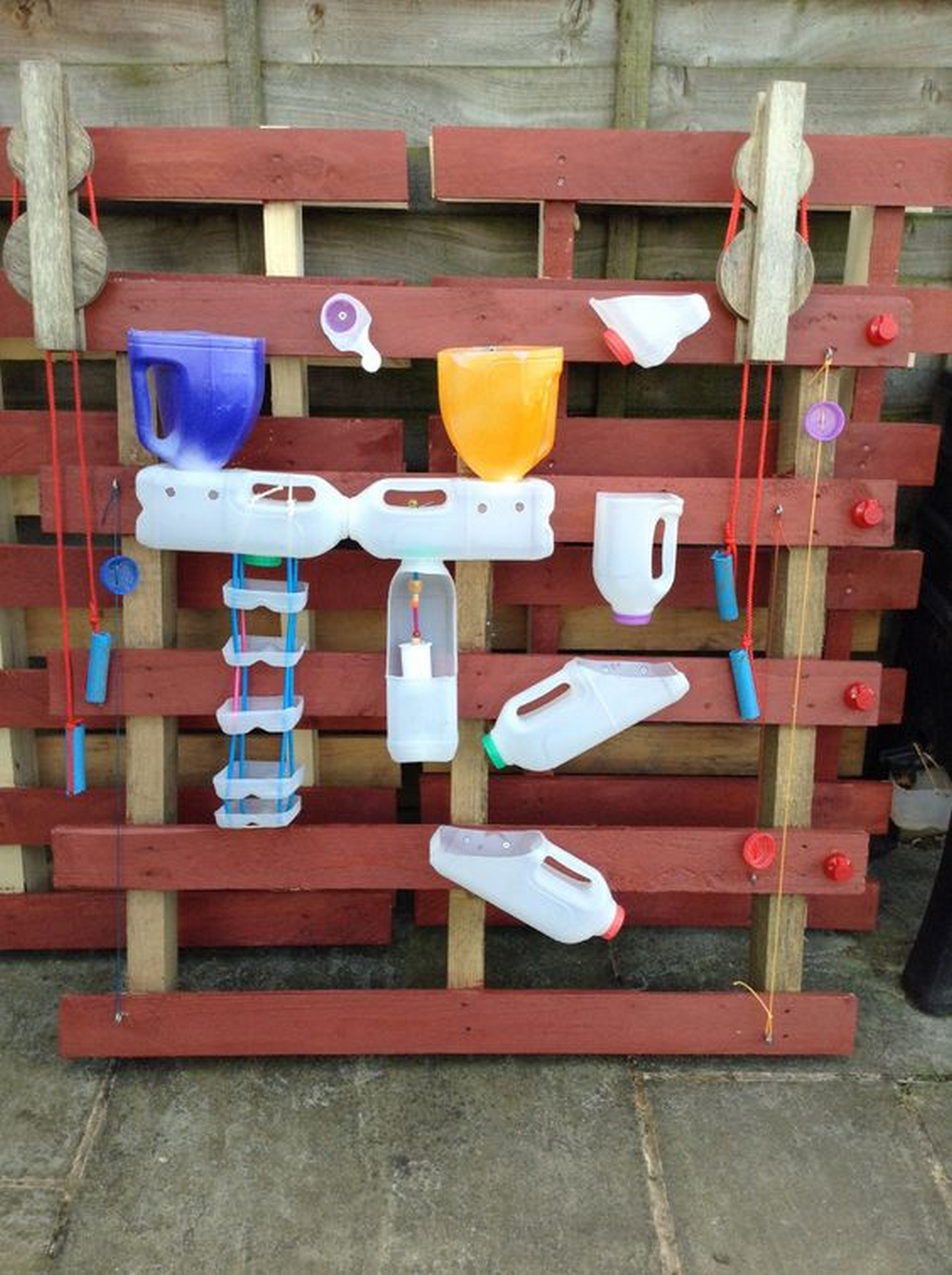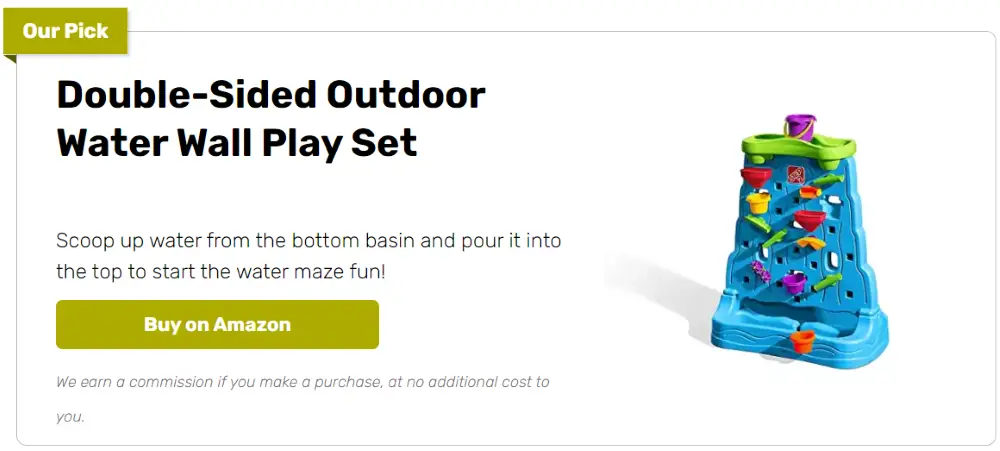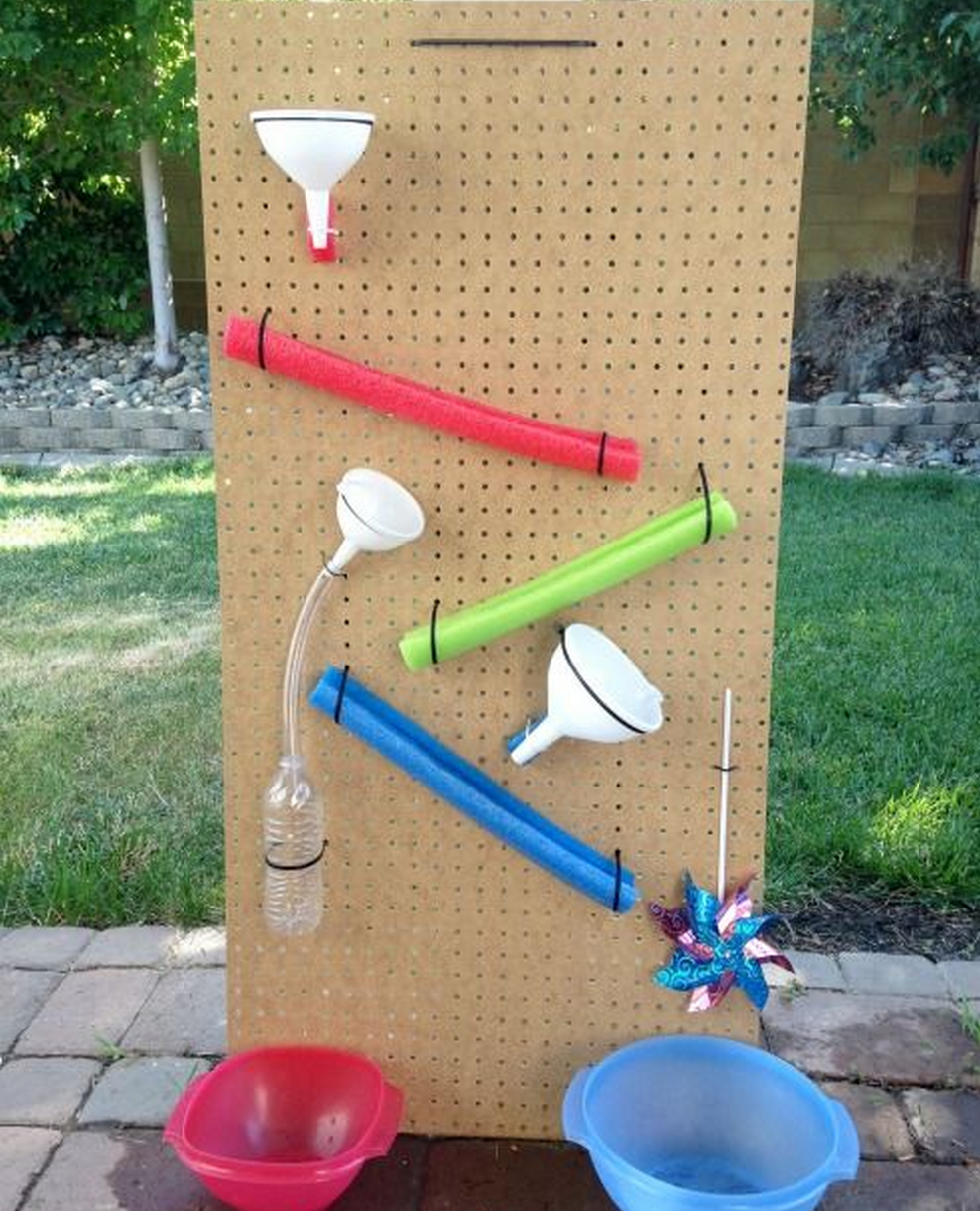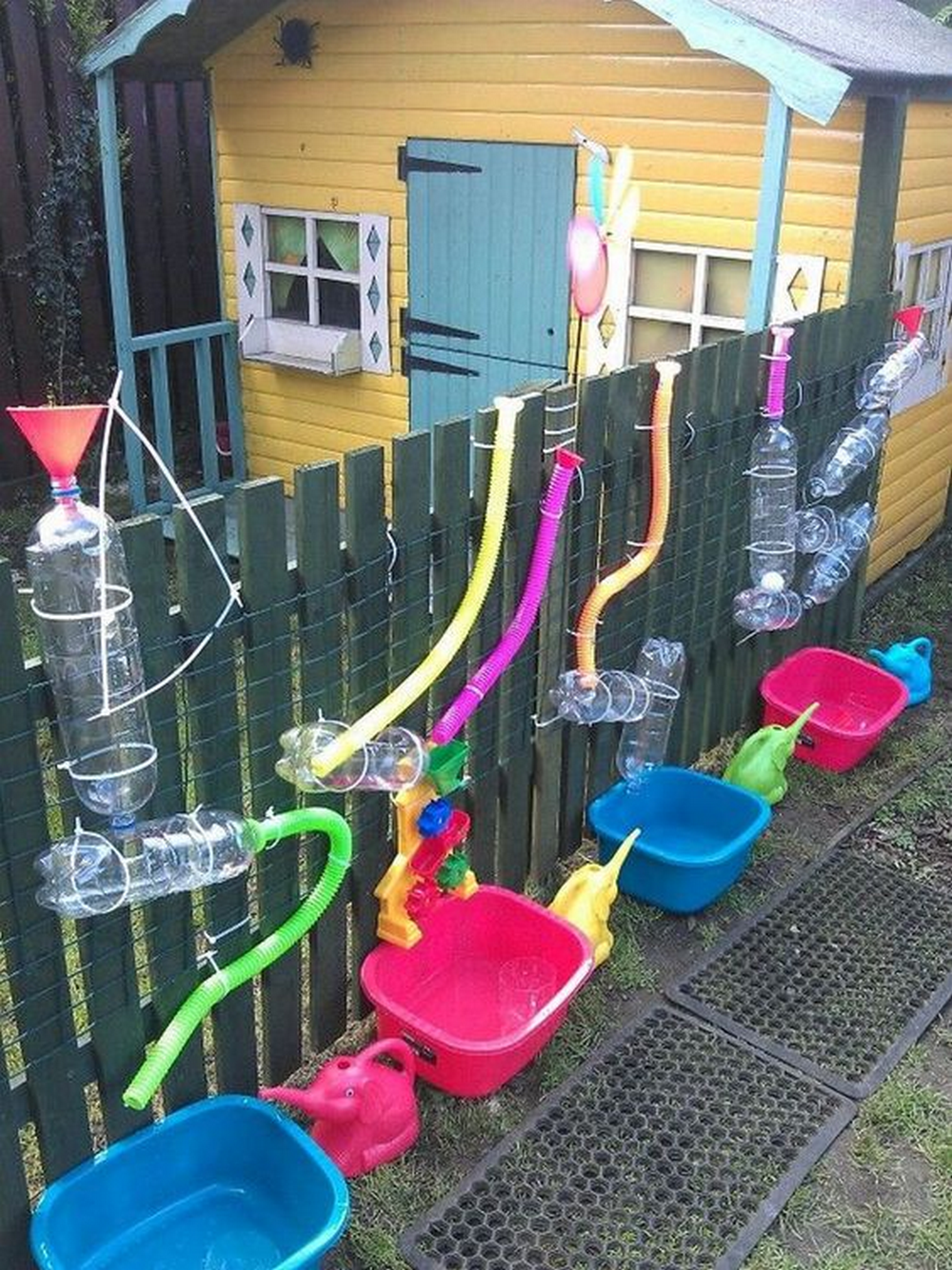
It’s good to encourage kids to play outdoors. They become physically active, adventurous, and learn social skills. These are some of the reasons why I try my best to provide engaging outdoor activities for my kids. I don’t want them stuck indoors, their faces glued to the TV screens or their tablets.

Because I’m perpetually searching for new and fun outdoor activities, I discovered the water wall. Basically, you pour water at the top and it goes through several “levels” before it reaches a container at the end. It’s fun for the kids and I’m happy.

You can make this project with the whole gang – I mean the kids. It doesn’t involve high-powered tools so it’s safe. Plus, it stimulates creativity and learning. I’m pretty sure this will be a big hit.
Contents
Making a Water Wall
Materials
- Peg board
- Funnels
- Clear vinyl tubing
- Pool noodles
- Zip ties
- Plastic bottles
Tools
- Scissors
Instructions
Step 1: Prepare the Peg Board
- Choose a suitable location for your water wall, ideally outdoors where water spillage won’t be an issue.
- If the peg board isn’t weather-resistant, consider applying a waterproof sealant to prolong its life.
Step 2: Design Your Water Pathways
- Lay out the peg board on the ground.
- Arrange the funnels, plastic bottles (cut in half to act as channels), and pool noodles (sliced lengthwise to create troughs) on the peg board to design your water pathways.
- Experiment with different arrangements to see how water flows through various paths. Aim for a mix of steep and gentle slopes to make the flow more interesting.
Step 3: Secure the Components
- Once you’re satisfied with your layout, use the scissors to cut the pool noodles and plastic bottles as needed.
- Secure each item to the peg board with zip ties. Make sure funnels and tubing lead into bottles or noodles to direct the water effectively.
- Ensure all components are tightly fixed to avoid dislodging when water flows through them.
Step 4: Install the Vinyl Tubing
- Cut lengths of clear vinyl tubing to connect different sections of your water wall. This tubing can help extend the water’s path or create surprising water drops for extra fun.
- Use zip ties to attach the tubing securely to the peg board and ensure a good fit with funnels and noodle sections to prevent leaks.
Step 5: Test and Adjust
- Stand the peg board up in the chosen location. You might need to support it against a wall or fence, or create a stand.
- Pour water into the top funnel and watch how it travels through your water wall. Make adjustments as necessary to improve the flow or fix any leaks.
- Check all connections and make sure the water smoothly transitions from one component to the next.
Step 6: Play and Learn
- Invite your kids to pour water, observe how gravity and flow dynamics work, and encourage them to make modifications themselves.
- Discuss why certain paths work better and the effects of angles and heights on water flow.
Click on any image to start the lightbox display. Use your Esc key to close the lightbox.









For visual instructions, check out the video below.
Benefits of Water Play for Child Development
Water play is an integral part of childhood development, offering numerous benefits that extend far beyond simple amusement. When children interact with water, they engage in a sensory experience that enhances both physical and cognitive development. A DIY water wall, for instance, serves as a perfect tool to facilitate this type of play.
Here’s a deeper look into how water play can positively impact child development.
Enhances Fine Motor Skills and Coordination
Engaging with a water wall requires children to use their hands in intricate ways, whether they are pouring water, gripping objects soaked in water, or manipulating the path of the flow. This type of play helps in refining their fine motor skills and hand-eye coordination. As they focus on tasks such as aiming the flow or connecting different elements of the water wall, they develop dexterity and control.
Promotes Understanding of Scientific Concepts
Water walls are fantastic for introducing basic scientific and mathematical concepts in a tangible way. Children learn about gravity, water flow, volume, and cause and effect as they observe how water moves and reacts in different scenarios. This type of exploratory play encourages curiosity and cognitive development, as children hypothesize and test their ideas about how the world works.
Encourages Social Skills and Teamwork
Working with a water wall often involves other peers, making it a social activity where children must communicate and cooperate. They learn to share ideas, negotiate space and materials, and work collaboratively to solve problems, such as how to direct the water flow or fix a leak. These interactions are crucial for developing strong social and teamwork skills.
Stimulates Creative Thinking and Problem Solving
Interacting with a water wall invites children to use their imagination and creativity. As they experiment with how water behaves when manipulated by various objects and structures, they are encouraged to think creatively to enhance or change the effects. This kind of open-ended play helps develop critical thinking and problem-solving skills as children determine the best ways to achieve desired outcomes or overcome obstacles in water flow.
Enhances Sensory Experience
Water play is inherently sensory, providing tactile feedback that is vital for sensory development. Children experience different temperatures, pressures, textures, and sounds as they engage with the water wall. This rich sensory environment helps refine neural pathways, enhancing sensory processing abilities which are crucial for all types of learning.
Supports Emotional and Stress Relief
Water is naturally calming, and playing with a water wall can significantly reduce children’s stress and anxiety levels. The repetitive motions of scooping, pouring, and splashing can be meditative, helping children regulate their emotions and calm down from overstimulation. It also provides a safe outlet for expressing feelings through vigorous water play or focused, quiet play.
Develops Language and Communication Skills
As children describe what they’re doing or plan strategies with peers around the water wall, they naturally expand their vocabulary and improve their communication skills. They learn new words and concepts related to water and physics, and articulate their thoughts in order to share ideas or give instructions. This linguistic practice is crucial in early childhood, where language skills are rapidly developing.
Parents and educators can foster an environment that promotes significant developmental benefits by providing children with water play opportunities through setups like a water wall. This type of play not only captivates children’s interest but also serves as a foundation for learning through play, making it an invaluable component of childhood education.
Tips for Water Wall Maintenance and Safety
Maintaining and ensuring the safety of a water wall is essential to provide children with a fun and hazard-free play environment. Regular checks and upkeep can prolong the life of your water wall and make it a safe spot for creative and educational play.
Here are some tips to help you keep your water wall in top condition and ensure it remains a safe area for kids.
Regular Cleaning
- Prevent Algae and Blockages: Water walls can develop algae and debris blockages over time, especially if they are outdoors. To prevent this, clean the water wall regularly using a mixture of vinegar and water, which is safe for children and effective against algae. Rinse all elements thoroughly with clean water after cleaning.
- Check for Sediment: If your water wall uses recycled water, check for sediment build-up which can clog the system. Clean out any accumulated sediment in containers or hoses to ensure smooth water flow.
Inspect and Replace Materials
- Check for Wear and Tear: Regularly inspect all components of the water wall, such as tubing, connectors, and plastic bottles, for signs of wear or damage. Replace any items that are broken or worn out to prevent hazards like sharp edges or choking risks from small broken parts.
- Material Durability: Ensure that all materials used are durable and suitable for extended outdoor use if the water wall is not portable. Materials that degrade under UV exposure or weather conditions should be checked more frequently and replaced as needed.
Ensure Structural Stability
- Secure Installation: Make sure the water wall is securely installed. If it is a freestanding structure, ensure it is stable and cannot easily be tipped over by children playing. For water walls attached to fences or walls, check that all mountings are secure and robust.
- Stabilize Movable Parts: If your water wall includes elements that can be rearranged, ensure that these parts can be securely fixed in place while in use to prevent accidents.
Safe Water Practices
- Clean Water Supply: Always use clean water to reduce the risk of bacterial growth. If the water is recycled in the system, consider how long it stays in the system and refresh it regularly.
- Avoid Slip Hazards: Ensure that the area around the water wall has proper drainage or is made from non-slip materials to prevent falls from slippery surfaces.
Monitor for Safe Play
- Supervise Young Children: Always supervise young children when they are using the water wall to ensure they are using it safely and correctly.
- Educate on Proper Use: Teach children how to use the water wall safely, including not climbing on it and using toys and tools appropriately. This education can help prevent accidents and encourage respectful and safe play.
Following these maintenance and safety tips will help keep your water wall a delightful and secure play area, promoting both fun and learning in a safe environment.
Conclusion
Creating a water wall offers an excellent opportunity for children to explore and learn through interactive play. Regular maintenance and adherence to safety guidelines ensure that this playful structure remains both fun and safe for everyone involved. As children engage with a water wall, they not only enjoy themselves but also develop crucial skills across multiple developmental areas.






